1.2 HOW SCIENTISTS DO SCIENCE
Science provides a story about the natural universe around us. It is a story that inspires wonder and, at the same time, has enormous practical implications for every aspect of human existence. As is the case for any scientific discipline, success in molecular biology is defined to a large extent by the contributions a scientist makes to the larger scientific story. That ongoing story provides a context and community within which scientists frame every experiment.
The history and philosophical underpinnings of science have brought about guidelines and rules for new experimentation at every level of this intertwined enterprise. The scientific community is highly interactive, with ongoing discussions supplying both constraints and insights that can stimulate progress. The collective discussion is carried out in informal conversations, at scientific meetings, and, most importantly, in the peer-
Molecular biology is a scientific enterprise, giving rise both to information, as conveyed in the chapters of this text, and to future advances. An understanding of the scientific enterprise can help in our assimilation of existing information and accelerate success in any scientific effort.
Science Is a Path to Understanding the Natural Universe
Science is both a body of knowledge and a process for generating that knowledge. In the scientific community, scholars attempt to answer questions about the natural universe. Since the dawn of humanity, people have employed many approaches to understanding the world around them, guiding human development for millennia. The modern version of the scientific method, relying on careful observation and experimentation, has been widely applied for only about four centuries.
The scientific approach to discovery has at least three characteristics. First, science focuses only on the natural universe. The realm of science is thus limited to what we can observe and measure. Second, science relies on ideas that can be tested by experiments and on observations that can be reproduced. Finally, the experiments are carried out within an ever-
Science makes one philosophical assumption: that forces and phenomena existing in the universe are not subject to capricious or arbitrary change. They can be understood by applying a systematic process of inquiry—
13
In modern science, an initial idea is called a hypothesis—a proposal that provides a reasonable explanation for one or more observations but is not yet substantiated by sufficient experimental tests to stand up to rigorous critical examination. A scientific theory is much more than a hypothesis; it provides an explanation for a body of experimental observations and is thus a firm basis for further inquiry. When a scientific theory has been repeatedly tested and validated by many types of experiments, it can be considered a fact.
Scientific hypotheses and theories can also be defined by their presence in the peer-
The Scientific Method Underlies Scientific Progress
The first recorded efforts to systematize scientific inquiry have been credited to the classical Greeks, who were clearly influenced by other civilizations in Babylon, Assyria, Egypt, Persia, and elsewhere (Figure 1-13). Key thinkers replaced trial and error, chance discoveries, and appeals to the supernatural with a more formalized system of reasoning. Euclid, Aristotle, Plato, and others made significant advances by using inductive reasoning, making a broad conclusion from specific facts (e.g., my stove is hot, my brother’s stove is hot, so all stoves are hot), and by deductive reasoning, forming a conclusion from a premise (e.g., premise: all flying organisms are birds; observation: a crow flies; conclusion: a crow is a bird). Experiments played a minor role. The process worked reasonably well for mathematics and engineering, less well for most other pursuits. Scientific progress declined in the West with the decline of the Roman Empire, symbolized by the assassination in 415 ce of the last director of the great library of Alexandria in Egypt, the accomplished Greek mathematician and philosopher Hypatia.

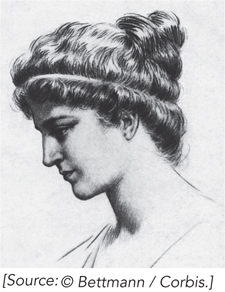
A reawakening began with the emergence of Islamic science during the Middle Ages, building on Greek and Roman ideas with rational arguments combined more liberally with observations and experiments. The physicist Abū ‘Alīal-
By the beginning of the seventeenth century, the flaws in Aristotelian philosophy had become clear to many scholars. René Descartes (1596–
14
In 1619, Descartes set down four rules for inquiry, which we paraphrase here: (1) never accept anything as true unless that truth can be clearly demonstrated; (2) reduce a problem to its parts; (3) begin with the simplest part and gradually work to the more complex; and (4) be thorough. Francis Bacon divided inquiry into a somewhat similar series of steps, first gathering relevant observations, and then deriving increasingly complex conclusions from them. Galileo combined careful observation and rational argument to develop new fields of inquiry.
The scientific method had matured by the beginning of the nineteenth century. In its most basic form, it begins with a question about nature. Relevant observations are made, and a hypothesis is crafted to explain them. Assumptions that underlie the hypothesis are defined, and each assumption is carefully tested by experimentation. Experimental results lead to acceptance, rejection, or modification of the hypothesis. Additional experiments can lead to the acceptance of a new theory or fact about the natural world.
In modern molecular biology, this now classical version of the scientific method underlies huge numbers of advances. One example is the discovery of the DNA-
The Scientific Method Is a Versatile Instrument of Discovery
The path to scientific discovery is rarely as rigid, linear, and empirical as implied in the preceding paragraphs. Molecular biology is certainly replete with examples of the purposeful application of the scientific method, but it is also full of surprises, excitement, and occasional messiness. Major discoveries are often characterized by hard work, extraordinary perseverance (a surprising number of discoveries seem to be consummated in the middle of the night), and more than a little innovative thinking. Many such examples are chronicled throughout this book.
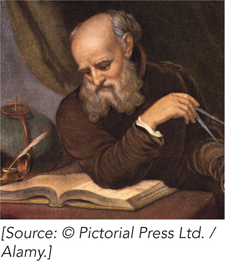
To understand how science is done, we need to expand the concept of the scientific method to include the contribution of scientific context. Scientific inquiries are not carried out in a vacuum. The discovery of DNA polymerase, described above, was much more than “hypothesize the existence of this enzyme and then go get it.” The search was carried out in the context of the ideas and facts that prevailed at the time. These included information about the structure of DNA, the chemistry and thermodynamics of enzyme catalysis, cellular physiology and metabolism, the properties of proteins, and the recent finding of a related enzyme, ribonucleotide phosphorylase, by Severo Ochoa. The entire discovery process was guided by the interconnected web of theories and information within which the DNA polymerase hypothesis was developed and tested.
To understand the scientific method, it is also instructive to examine other examples of how important ideas were conceived and tested. The examples below are meant to demonstrate the variety of ways in which science is advanced, and they underscore the fact that science is a very human experience, despite the rigor of the discipline.
Hypothesis and Discovery This classical path to scientific discovery led Kornberg and colleagues to DNA polymerase. It was also used by Jack Szostak in his exploration of prebiotic chemistry (see Moment of Discovery at the opening of this chapter), as well as by countless other scientists. Bob Lehman describes the quite similar path to his discovery of DNA ligase, an enzyme that joins segments of DNA (see the Moment of Discovery for Chapter 11). These discoveries started with hypotheses and ideas reasonably based on the knowledge of the time, and the hypotheses were carefully tested. In addition, the discoveries were made within a broader context of constraints imposed by theories related to the geologic history of our planet, basic chemistry, nucleic acid chemistry, structural biology, the properties of enzymes, and many other areas of knowledge.
15
Model Building and Calculation As we will see in Chapter 6, Watson and Crick relied on intuition and important experimental clues from other researchers to build a model of DNA structure so clearly fitting the data that its acceptance was both shocking and immediate. A similar approach can be seen in the work of Steve Mayo in his efforts to deduce the three-
Hypothesis and Deduction Soon after the structure of DNA was determined, it became apparent that the information in DNA is converted into RNA, and then into protein. However, how amino acids could bind to RNA molecules to guide assembly of the amino acids into proteins remained unclear. Then, in 1955, Crick wrote an influential note to some colleagues that laid out his “adaptor hypothesis,” proposing that there was an as yet undiscovered molecule that linked each amino acid to sequence information in the RNA. This insight, never published but widely disseminated, was not an endpoint. The hypothesis was subjected to experimental confirmation, and the adaptor—
Exploration and Observation Darwin’s voyage on the Beagle was not designed to answer the questions that his work eventually addressed, and no hypotheses were offered when the ship set sail. Thousands of individual observations (and context provided by the work of many predecessors and contemporaries) simply gelled in a great mind to create a transformational theory. Molecular biologists routinely embark on similar voyages, with computers and new technologies as vessels of discovery. Rather than focusing on one or a few enzymes and reactions, we can now approach issues related to entire systems. Cells, organisms, and even ecosystems are being explored. Many of these technologies are described in Chapter 8. The new technologies enable us to explore broadly, asking: what’s out there that we have missed? These efforts provide a rich context for new ideas and hypotheses.
Inspiration The polymerase chain reaction, often abbreviated PCR, is a convenient process for amplifying a DNA sample. PCR is now so integral to biotechnology and forensic science that it is hard to imagine doing molecular biology without it. PCR was invented by Kary Mullis in a flash of inspiration that came to him while driving along a northern California highway in 1983. Reflecting on one problem, Mullis stumbled on a solution to an even greater one: a method to produce almost unlimited copies of a DNA sequence in a test tube. (This story is presented in more detail in the How We Know section in Chapter 7.) Although this advance was not precipitated by an orderly application of the conventional “question, hypothesis, experiment” approach, the inspiration was a logical and probably inevitable outgrowth of the growing body of knowledge that constituted the molecular biology of that moment.
Serendipity Accidental discoveries are, by definition, unplanned and unexpected, and they can change the way we think about living systems. Such discoveries are not preceded by a carefully orchestrated quest organized around a posed question. They just happen—
These many pathways vary in detail, but they have characteristics in common that identify them as part of a modern and adaptable scientific method. They all focus exclusively on questions and properties related to the natural universe. All the ideas, insights, and experimental facts that arise from these endeavors rely on reproducible observation and/or experiment. Ultimately, the information from the various approaches fits into the web of scientific knowledge. The experimental efforts and results can be used by other scientists anywhere in the world to build new hypotheses and make new discoveries. An attempt to construct a flow chart for a realistic application of the scientific method is shown in Figure 1-14
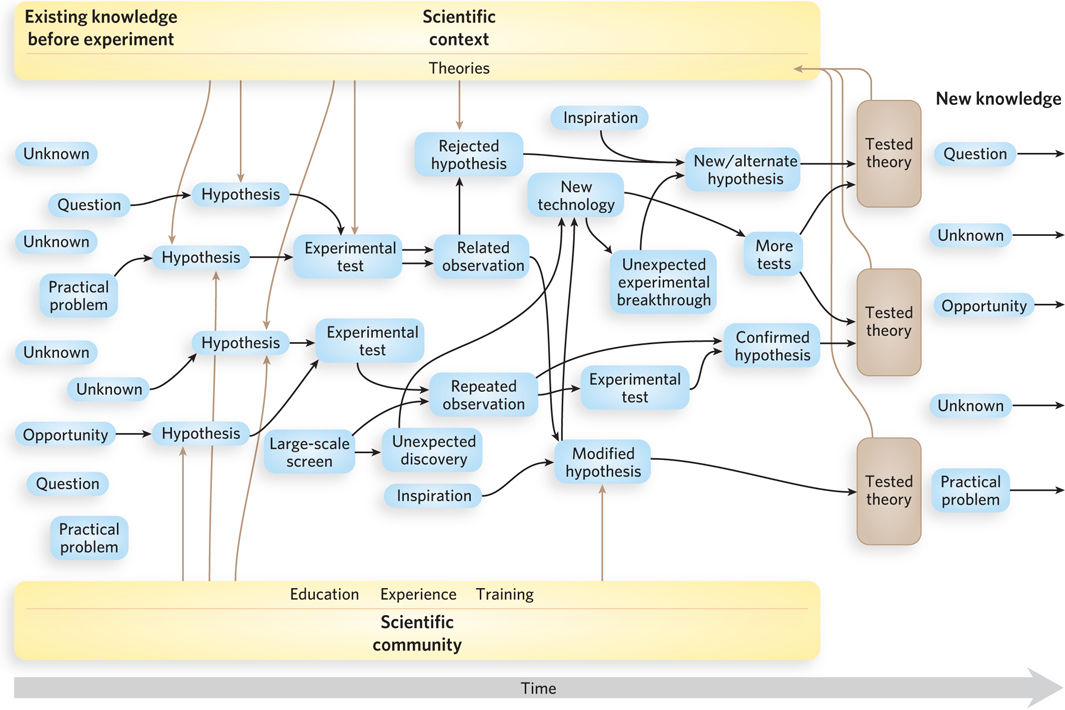
16
Scientists Work within a Community of Scholars
Any individual who uses the scientific method to answer questions about the natural universe is a scientist—
Scientific training is much more than lessons about experimental methods; it is an education in how to think about and approach scientific problems. Progress often demands a willingness to give up a favorite hypothesis. In his book Advice to a Young Scientist (1979), the Nobel Prize winner Peter Medawar expressed it thus: “I cannot give any scientist of any age better advice than this: the intensity of the conviction that a hypothesis is true has no bearing on whether it is true or not.”
If any idea about the natural universe does not align with reproducible observations, a scientist must challenge it. Except for the postulate of objectivity, no assumption is inviolate. The ideas that a scientist accepts must be based on evidence that can be observed, measured, and reproduced. The standard of reproducibility, coupled with the continual advance of new experimentation, provides a robust system for weeding out the inevitable errors and for guiding insightful reinterpretations.
The many decisions along any path to discovery, such as determining the number and types of tests to use in examining a hypothesis, are guided by training and experience. There is no prescribed formula for these decisions, but they are much less subjective than they might at first appear. The context of scientific theory and information plays a major role in ensuring rigor. When a DNA-
17
When a result contradicts the original hypothesis, a scientist must decide whether to reject or revise. This decision is similarly rooted in both the context of scientific information known at the time and the experience of the investigator. When Bob Lehman and colleagues detected the action of DNA ligase (in the bacterium Escherichia coli) for the first time, they anticipated that a high-
In science, the work is not done by individuals in isolation, and scientific decisions are influenced and affected by the scientific community at large. It is not enough to demonstrate a new idea to oneself. To integrate an advance into the web of scientific information, a scientist must make a case that is compelling to the broader community. A continual discussion within this community fosters progress and helps ensure the integrity of the information generated. A few years after Kornberg first isolated DNA polymerase, the involvement of this enzyme in chromosomal replication was questioned. The rate at which it synthesized DNA seemed insufficient to match the observed rate of chromosomal duplication in cells, and cells somehow survived when the gene encoding the enzyme was eliminated. These observations led to discovery of another DNA polymerase in the same bacteria, now called DNA polymerase III, that serves as the primary enzyme in chromosomal replication. The original DNA polymerase (now called DNA polymerase I) is more abundant than DNA polymerase III, hence its initial detection. DNA polymerase I has a variety of auxiliary functions in DNA replication and DNA repair, as we will see in Chapters 11 and 12.
When an idea is tested, the most compelling case is made when the idea passes multiple tests involving two or more different techniques. Collaboration among scientists often strengthens the case. Different individuals bring different perspectives and expertise to bear on a problem. The cross-
Ultimately, this literature documents the scientific story about the natural universe. That story is ever expanding, never complete, and always ready for new contributors.
SECTION 1.2 SUMMARY
Science is both a body of knowledge and a process of inquiry by a community of scholars. Science is a path to knowledge about the natural universe, relying on reproducible observation and experiment. Science relies on one foundational assumption: the postulate of objectivity, that the universe is governed by immutable, and therefore discoverable, laws.
The classic form of the modern scientific method poses questions, generates explanatory hypotheses, and tests the hypotheses with experiments. Hypotheses are accepted, rejected, or modified depending on the results of the experiments.
The scientific method is malleable, and there are multiple paths to scientific knowledge. All pathways are linked by a reliance on reproducible observation or experiment and by their capacity to generate knowledge consistent with the broader context of scientific information.
Scientists are individuals who apply the scientific method to answer questions about the natural universe. Their decisions are guided by training, their knowledge of the scientific context of their work, and continuing interactions with the worldwide scientific community.
UNANSWERED QUESTIONS
The questions that are relevant to this introductory chapter include some of the most fundamental and far-
What is the minimal set of genes required in a living cell? Efforts to define a cell at its most basic level are well underway. Scientists may create an engineered cell in the near future. The research has practical implications, because such a cell could be a living scaffold for the engineering of cells to bioremediate toxic waste or generate biofuels. The work should also tell us something about LUCA. To this end, a completely synthetic version of the genome of the bacterium Mycoplasma mycoides has been constructed and transplanted into recipient cells, where it displaced the resident DNA. A more complete engineering of an artificial cell remains a goal.
18
Can we reconstruct the entire tree of life? Developing a complete tree of life is an ongoing effort of evolutionary biology, making use of the tools of molecular biology and complementary information from the fossil and geologic records (see Chapter 8).
What is the full set of mechanisms that drive evolution, and how much does each mechanism contribute? Genetic variation in a species results from spontaneous DNA damage, replication errors, transposition, DNA repair processes gone awry, genetic recombination, and many other processes. Molecular biology provides the roadmap to a comprehensive listing and understanding. Many mechanisms are increasingly understood, but surprises are still common.
Can evolution be controlled? When bacteria are subjected to stress, specific sets of genes turn on in programmed responses. One part of that response in E. coli involves the production of higher levels of mutagenesis. Can the development of resistance of pathogenic bacteria to antibiotics—
an increasing problem in medical treatments— be slowed by inhibiting bacterial stress responses to DNA damage? Some academic and biotechnology industry researchers around the world are betting that it can.
19
Adenine Could Be Synthesized with Prebiotic Chemistry
Ferris, J.P., and L.E. Orgel. 1966. An unusual photochemical rearrangement in the synthesis of adenine from hydrogen cyanide. J. Am. Chem. Soc. 88:1074.
Oro, J., and A.P. Kimball. 1962. Synthesis of purines under possible primitive Earth conditions. II. Purine intermediates from hydrogen cyanide. Arch. Biochem. Biophys. 96:293–
Few biomolecules are more important than adenine. It is the base component not only of the adenine nucleotides in RNA and DNA but also of a wide range of enzyme cofactors, including ATP (adenosine triphosphate), an important energy source that drives many cellular reactions. Thus, over the course of evolution, adenine took on a larger role than other nucleotide bases in the biochemistry of living systems, presumably reflecting some particular aspect of the evolution of life. Experiments carried out by Juan Oro in the 1950s and early 1960s, and continued by Leslie Orgel and colleagues, demonstrated that there are good chemical reasons to think that adenine may have been present in much higher concentrations than other nucleotide bases in the prebiotic soup. This suggests that adenine’s current place in the scheme of life reflects the conditions when life was formed: adenine was there!
One of the most common reagents generated from the molecules thought to predominate in the atmosphere of early Earth is hydrogen cyanide (HCN). HCN can be converted into a variety of organic molecules, one of the most abundant products being adenine. Adenine can be synthesized from HCN in several ways, but the scheme shown in Figure 1 is the most plausible under the conditions believed to have existed on early Earth. An HCN tetramer forms in the first step (Figure 1a), and this reacts with formamidine (also formed from HCN) to produce 4-
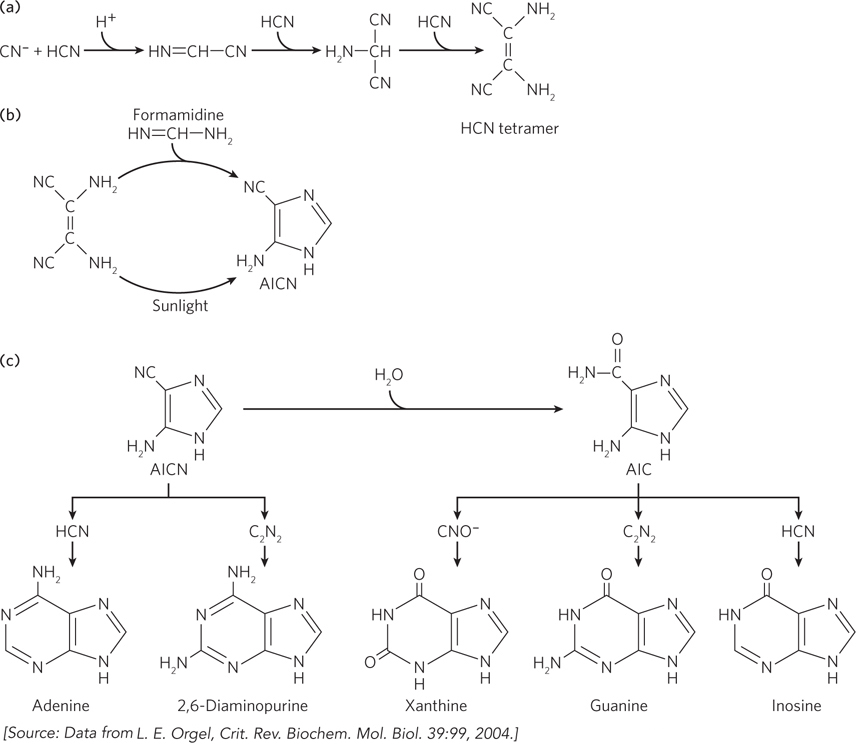
20
Clay Had a Role in Prebiotic Evolution
Hanczyc, M.M., S.M. Fujikawa, and J.W. Szostak. 2003. Experimental models of primitive cellular compartments: Encapsulation, growth, and division. Science 302:618–
Huang, W.H., and J.P. Ferris. 2003. Synthesis of 35–
Sodium montmorillonite, first mined at Fort Benton, Wyoming, and commonly known as bentonite, is a type of clay used commercially. It generally contains various mineral impurities (10% to 20%) that give it a layered aluminosilicate structure. The clay readily expands to permit large molecules to enter the interlayers. Products making use of montmorillonite clays include lubricating grease, paints, copy paper, dynamite, plaster, cat litter, matches, cement tiles, shoe polish, concrete, cleaning agents, wall boards, crayons, and bleaching agents. Some forms of montmorillonite are claimed to have health-
Any nucleotides formed in the prebiotic soup would have had to be joined into polymers before the properties of RNA could be exploited by evolution. Wenhua Huang and James Ferris demonstrated that a phosphoramadite-
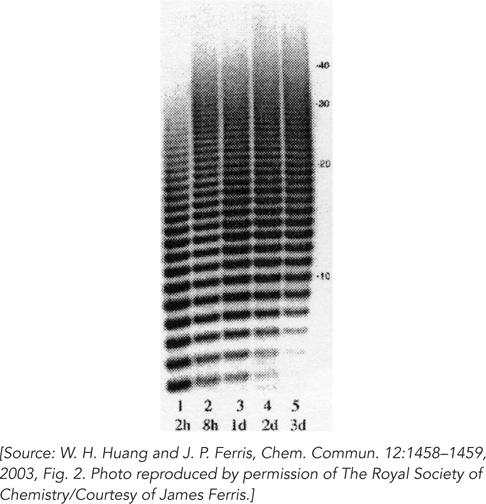
Jack Szostak’s research group has long been interested in identifying reactions that might explain how early replicating polymers could have become enclosed in lipid envelopes (see this chapter’s Moment of Discovery). Szostak and his coworkers found that montmorillonite clay facilitates the conversion of lipids into vesicles. In their experiments, clay particles often became entrapped in the vesicles, bringing with them any RNA embedded in the particle surfaces. As more lipids were added, the vesicles would grow and bud off, without dilution of their contents. This system models many properties of a primordial cell.
We have included here just a small sampling of studies exploring the properties of this unusual clay material. A wide array of reactions are facilitated by this clay, many of them of interest to evolutionary biologists.
21
Darwin’s World Helped Him Connect the Dots
Mayr, E. 2000. Darwin’s influence on modern thought. Sci. Am. 283(July):78–
Padian, K. 2008. Darwin’s enduring legacy. Nature 451:632–
Darwin was not the first to come up with the idea of evolution. The sense that the world changes over time and that the organisms inhabiting it also change can be traced back to classical Greece. By the end of the eighteenth century, the study of geology had impressed on the scientists of the day that Earth is much older than previously thought and that the environment changes over time. The discovery of and growing interest in fossils had similarly shown that there were animals on Earth in past eras that were no longer present. They had either become extinct or undergone great changes in appearance.
One of the first influential efforts to explain all these observations came from the French biologist Jean-
Lamarck’s ideas were hotly debated for many decades, and a variety of competing ideas about the transmutation or transformation of animals and plants appeared in contemporary writings. The basic idea that organisms change, or evolve, over time was familiar, if not well accepted, before Darwin presented his theory of evolution in The Origin of Species. However, until he set pen to paper, no plausible mechanism of evolution had been proposed.
Drawing on his experiences during the 1831–
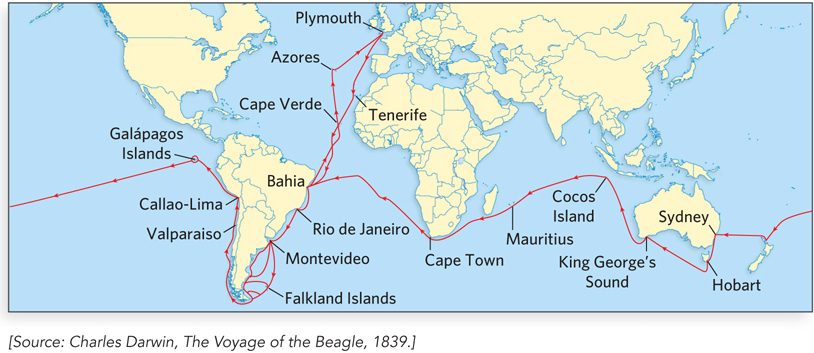
Darwin was influenced by the works of Thomas Malthus (1766–
Darwin’s great work was published in 1859, after he discovered that similar ideas had been developed by Alfred Russel Wallace (1823–
22